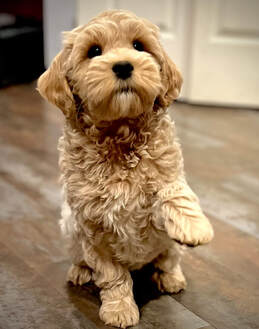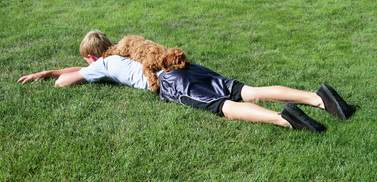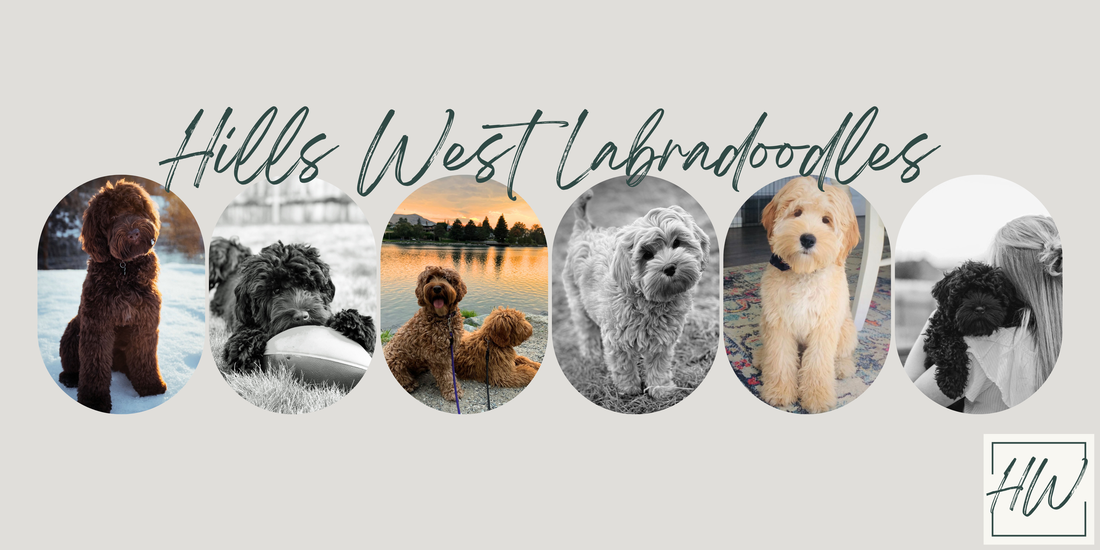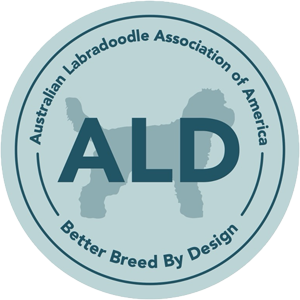Labradoodle Information
The Labradoodle cross has been around for many decades was intentionally bred in Australia in the 1980's. Labradoodles were developed primarily as healthy allergy friendly dogs with unique intuitive, easily trainable mind suited for assistance dogs for the physically or emotionally challenged child or adult. The combination of the Labrador retriever and the Standard Poodle created a special kind of dog with the attributes of the Labrador retriever, easy tempered working dog for service, being adored for its loyalty, warmth and gentleness made the perfect complement to the poodle, which is hailed for its superior intelligence, trainability, lack of shedding, and allergy-friendly coat.
From here further development was done with parent breed infusions added to the Labrador x Poodle cross lines. The developers of the breed sought out complimentary attributes to develop the qualities that we now find and love in the
Australian Multi-Gen Labradoodle. Over the years breeding practices expanded to create superior traits, both in physical conformation and mental temperament that were required of an assistance dog.
In 2004 it was announced that the Australian Labradoodle was not just a Labrador x Poodle cross but it was a breed in its own right developed over many years with particular goals in mind.
Recognized by the ALAA, WALA, IALA, and the ALCA.
Australian Multigenerational Labradoodles that are carefully selected for health and temperament display amazing intuition and trainability. These allergy friendly dogs have a calm and steady demeanor and live to take care of their human companions. Ask any owner of an Australian Muli-generational Labradoodle and they will attest to the intelligence and sweet soft spirit of these dogs. Not only are the pups as cute as can be, their attributes, along with their allergy-friendly coats, makes the labradoodle one of the most sought after pets and family companion.
From here further development was done with parent breed infusions added to the Labrador x Poodle cross lines. The developers of the breed sought out complimentary attributes to develop the qualities that we now find and love in the
Australian Multi-Gen Labradoodle. Over the years breeding practices expanded to create superior traits, both in physical conformation and mental temperament that were required of an assistance dog.
In 2004 it was announced that the Australian Labradoodle was not just a Labrador x Poodle cross but it was a breed in its own right developed over many years with particular goals in mind.
Recognized by the ALAA, WALA, IALA, and the ALCA.
Australian Multigenerational Labradoodles that are carefully selected for health and temperament display amazing intuition and trainability. These allergy friendly dogs have a calm and steady demeanor and live to take care of their human companions. Ask any owner of an Australian Muli-generational Labradoodle and they will attest to the intelligence and sweet soft spirit of these dogs. Not only are the pups as cute as can be, their attributes, along with their allergy-friendly coats, makes the labradoodle one of the most sought after pets and family companion.
In your research of Labradoodles you will find many terms such as F1, F1B and Multi-Gen.
Generations
First Generation labradoodle or F1 - The result of the breeding of a Labrador retriever to a poodle. Coats can be somewhat inconsistent at this stage. The F1 puppy may be shedding or non-shedding, and its coat may be wavy or wispy. The pups may vary greatly in appearance within the same litter. This puppy is a 50/50 mix of a lab and a poodle. The pup will have a wonderful temperament and make a trainable companion. An F1 cannot, however, be counted on to be suitable for those who suffer from allergies or asthma. Hills West Labradoodles does not sell F1 puppies.
F1b labradoodle or F1b is the result of the purposeful crossing back of the F1 dog to a poodle. This is done to produce the fleece coat with a lightly springy silk feel. It is more likely suited for allergy sufferers and will be low to non-shedding.
The Multi-Generational Labradoodle is typically non-shedding or very low shedding. It is the crossing of F1B to F1B or Multi-Gen to F1B, or Multi-Gen to Multi-Gen. It is the result of careful planning for temperament and conformance to the breed for several generations. Both F1B and Multi-Gen Labradoodles provide the coat and low- to non-shedding quality that Labradoodles are known for.
Australian Multi-Generational Labradoodles - Usually is the result of crossing an Australain Multi-Gen Australian labradoodle to another Australian Multi-Gen labradoodle. The Foundation dogs developed at the research centers in Australia have infusions of the following breeds:
1) Poodle
2) Labrador Retriever
3) Irish Water Spaniel
4) Curly Coat Retriever
5) American or English Cocker Spaniel
Each of these foundational infusions were used to strengthen desirable attributes for temperament, health, coat and conformation (body structure).
These qualities are what set the Australian Multi-Gen Labradoodle apart from any other type of Labradoodle. Hills West Labradoodles does not breed back to F1 (first generation Labradoodles) or poodles.
Generations
First Generation labradoodle or F1 - The result of the breeding of a Labrador retriever to a poodle. Coats can be somewhat inconsistent at this stage. The F1 puppy may be shedding or non-shedding, and its coat may be wavy or wispy. The pups may vary greatly in appearance within the same litter. This puppy is a 50/50 mix of a lab and a poodle. The pup will have a wonderful temperament and make a trainable companion. An F1 cannot, however, be counted on to be suitable for those who suffer from allergies or asthma. Hills West Labradoodles does not sell F1 puppies.
F1b labradoodle or F1b is the result of the purposeful crossing back of the F1 dog to a poodle. This is done to produce the fleece coat with a lightly springy silk feel. It is more likely suited for allergy sufferers and will be low to non-shedding.
The Multi-Generational Labradoodle is typically non-shedding or very low shedding. It is the crossing of F1B to F1B or Multi-Gen to F1B, or Multi-Gen to Multi-Gen. It is the result of careful planning for temperament and conformance to the breed for several generations. Both F1B and Multi-Gen Labradoodles provide the coat and low- to non-shedding quality that Labradoodles are known for.
Australian Multi-Generational Labradoodles - Usually is the result of crossing an Australain Multi-Gen Australian labradoodle to another Australian Multi-Gen labradoodle. The Foundation dogs developed at the research centers in Australia have infusions of the following breeds:
1) Poodle
2) Labrador Retriever
3) Irish Water Spaniel
4) Curly Coat Retriever
5) American or English Cocker Spaniel
Each of these foundational infusions were used to strengthen desirable attributes for temperament, health, coat and conformation (body structure).
These qualities are what set the Australian Multi-Gen Labradoodle apart from any other type of Labradoodle. Hills West Labradoodles does not breed back to F1 (first generation Labradoodles) or poodles.
Labradoodle Sizes

Labradoodles come in three officially recognized sizes, which means that there is a Labradoodle for every family and every size home.
The standard set by the Australian Labradoodle Association of America for the Australian Labradoodle and the Labradoodle are the same in reference to size and structure for the Miniature Labradoodle, Medium Labradoodle and Standard Labradoodle. Size is determined by measuring from the floor to the top of the shoulder.
Miniatures: 14–16 inches in height and 15-25 lbs in weight.
Mediums: 17–20 inches in height and 25-45 lbs in weight.
Standards: 21–24 inches in height and 50 to over 65 lbs in weight.
In general, the Labradoodle, either Australian or not, should appear athletic and graceful with a compact body that displays substance with medium boning. They should not appear cloddy or heavy nor overly fine in boning.
The standard set by the Australian Labradoodle Association of America for the Australian Labradoodle and the Labradoodle are the same in reference to size and structure for the Miniature Labradoodle, Medium Labradoodle and Standard Labradoodle. Size is determined by measuring from the floor to the top of the shoulder.
Miniatures: 14–16 inches in height and 15-25 lbs in weight.
Mediums: 17–20 inches in height and 25-45 lbs in weight.
Standards: 21–24 inches in height and 50 to over 65 lbs in weight.
In general, the Labradoodle, either Australian or not, should appear athletic and graceful with a compact body that displays substance with medium boning. They should not appear cloddy or heavy nor overly fine in boning.
Labradoodles Colors
There are a variety of colors available Labradoodle colors vary widely and include solid and "parti-colors”. The color names most commonly used are: Chalk, White, Cream, Gold, Apricot, Red, Chocolate and Black. Other colors you may hear are generally just variations of the colors listed.
It is important to note that slight variations in color will occur and a pup may not retain his original puppy color. At times, a puppy's coat will lighten with age but may surprise everyone by darkening. Unfortunately, there isn't an exact science as to what exact color your puppy will eventually become. Coat color will range in shade and intensity.
Chalk / White – White does not necessarily mean “white." Shades can range between white and cream.
Cream / Gold – This is richer in color than a chalk or white. Ranging from just hints of gold to a deeper gold.
Apricot - Visualize the fleshy part of a peach. Often apricots will fade some over time. But some do darken.
Red - A "true red" will be quite dark and red. Again, some will fade to an apricot but others will retain their deep dark red. Both are beautiful.
Chocolate - This color can range from a "dark chocolate" to a "milk chocolate." The chocolate color may stay a rich chocolate or fade over time.
Black - Unlike some of the other colors, a true black should retain their color. If there are any recessive genes in the line for silver or blue, the pup can fade to silver.
Parti - The base color is white with large areas of another color.
It is important to note that slight variations in color will occur and a pup may not retain his original puppy color. At times, a puppy's coat will lighten with age but may surprise everyone by darkening. Unfortunately, there isn't an exact science as to what exact color your puppy will eventually become. Coat color will range in shade and intensity.
Chalk / White – White does not necessarily mean “white." Shades can range between white and cream.
Cream / Gold – This is richer in color than a chalk or white. Ranging from just hints of gold to a deeper gold.
Apricot - Visualize the fleshy part of a peach. Often apricots will fade some over time. But some do darken.
Red - A "true red" will be quite dark and red. Again, some will fade to an apricot but others will retain their deep dark red. Both are beautiful.
Chocolate - This color can range from a "dark chocolate" to a "milk chocolate." The chocolate color may stay a rich chocolate or fade over time.
Black - Unlike some of the other colors, a true black should retain their color. If there are any recessive genes in the line for silver or blue, the pup can fade to silver.
Parti - The base color is white with large areas of another color.
The Labradoodle is a developing breed who currently demonstrates 3 very different coat types. It is essential that a buyer is familiar with each type and the benefits it affords in order to be completely satisfied with their doodle’s coat. We strive to produce allergy friendly coats in the richest colors.
Fleece coat: This is the coat that most people associate with a Labradoodle. The texture should be silky and light. It can range from being almost straight, (open fleece) with just a few waves in it (wavy fleece) to coat that almost has the look of a spiral perm (curly fleece). Regardless of the wave or curl this coat must be groomed in order to remain mat free. There should be no body odor and little to no shedding with this coat. Although it is typical to find the occasional “dust bunny” around the house with this coat, this coat is frequently acceptable for people with allergies.
Fleece: Open Fleece coat, non-shedding
Wavy fleece coat, non-shedding
Curly fleece coat, non-shedding
Wool coat: This coat is very dense and similar in texture to lamb’s wool. It can be kept long but requires more grooming in this style. Kept short this coat is very easy to maintain, has no odor and no shedding. This coat is the most poodle like and is best for those with severe allergies or asthma.
Wool coat: non-shedding
Hair coat: This coat is usually seen in early generation dogs. It is harsher in texture, can appear unkept, and may have doggie odors and varying degrees of shedding. If your Labradoodle has a low degree shedding coat, it must be groomed out. Typically this is a lower maintenance coat.
Hair coat: F1 and F1B Labradoodle, hair coat, slight shedding
Life Expectancy
12-15 years
Fleece coat: This is the coat that most people associate with a Labradoodle. The texture should be silky and light. It can range from being almost straight, (open fleece) with just a few waves in it (wavy fleece) to coat that almost has the look of a spiral perm (curly fleece). Regardless of the wave or curl this coat must be groomed in order to remain mat free. There should be no body odor and little to no shedding with this coat. Although it is typical to find the occasional “dust bunny” around the house with this coat, this coat is frequently acceptable for people with allergies.
Fleece: Open Fleece coat, non-shedding
Wavy fleece coat, non-shedding
Curly fleece coat, non-shedding
Wool coat: This coat is very dense and similar in texture to lamb’s wool. It can be kept long but requires more grooming in this style. Kept short this coat is very easy to maintain, has no odor and no shedding. This coat is the most poodle like and is best for those with severe allergies or asthma.
Wool coat: non-shedding
Hair coat: This coat is usually seen in early generation dogs. It is harsher in texture, can appear unkept, and may have doggie odors and varying degrees of shedding. If your Labradoodle has a low degree shedding coat, it must be groomed out. Typically this is a lower maintenance coat.
Hair coat: F1 and F1B Labradoodle, hair coat, slight shedding
Life Expectancy
12-15 years
Temperament

Labradoodles are known for their gentle, playful temperaments and intelligence. They are happy, loyal, affectionate, friendly, confident, non-aggressive, intuitive, and clever. They are easy to live with, train and a delightful family member to have. Owners must remember that Labradoodles tend to mature slowly and would benefit greatly from a foundation in puppy class, and a reasonable routine of daily exercise.
Labradoodles are easy to train, delightful companion, easy to live with and an absolute joy as a family member!
Curious as to why Labradoodles so expensive?
Multi-Gen Breeders purchasing a quality pup have quite an investment. For example: A Multi-Gen pup for breeding, on average sells for $10,000 here in the United States (more if directly from Australia). Once the pup arrives a preliminary health test is done by our Veterinarian. Then from the pup stage begins the training and several months later preliminary tests begin to see if this young adult meets breeding quality. Tests are performed in several departments, Hips, Elbows, PRA, DNA, CERF, Centronuclear Myopathy, Cystinuria, Degenerative Myelopathy, Exercise-Induced Collapse, Familial Nephropathy, Glycogen Storage Disease VII, Myotubular Myopathy 1, Narcolepsy, Neonatal Encephalopathy with Seizures, Progressive Retinal Atrophy, Progressive Rod-Cone Degeneration, Von Willebrand Disease I - each test results sent to different specialized National Boards for evaluation. The breeder must wait for all the results to come in before knowing if the young adult pup they selected will be of breeding quality.
Much time, effort and money is invested in each dog to become future parent dogs. Conscience Multi-Gen breeders testing for genetic problems accumulate large bills to ensure the integrity of their breeding dogs. These tests further the genetic health of the breed, adding to the costs from the pet purchaser but offering peace of mind knowing the best practices are put in place to offer the best quality of life for their future family member.
When you consider the quality of our parent dogs, the health testing performed, time invested in breed integrity, our commitment to the physical and mental health of our puppies and dogs, our health guarantee, and our lifetime of support, we feel our puppies are reasonably priced.
When you receive your pup from Hills West Labradoodles you know that you are getting the very best plus many expenses already taken care of for you saving you both time and money. The micro-chip in place, up to date vaccinations, worming and in many cases desexing already done. Ready for a lifetime of enjoyment!
Explaining the cost difference between Multi-Generational Labradoodles and F1s and F1Bs.
The F1 is a delightful companion, it is however, questionable in its non-shedding quality and higher energy level. The F1 may have a wispy-hair coat, which can be coarse to the touch. The Multi-Gen Australian Labradoodles have shown higher reliability with the desired low/or non-shedding coat. They are also known to have a more desirable feel, particularly the soft fleece coat. The Multi-Gen Labradoodle soft fleece is the coat which breeders purposefully breed toward. This is the dog which will be recognized by the AKC if that event should come to pass.
In general people will pay more for any breed of dog that is non-shedding and Australian Labradoodles simply have the best quality temperament for family companionship. The Multi-Gen breeder has invested significantly more money and generations (time) in breeding stock than the breeder of an F1 or F1b.
Time, thorough health testing and tracking of each parent in our program, along with special care of an in-home hands-on 24-hour care is invested in each puppy. Thinking about the initial investment, over the lifetime of a dog, this is very little per year of enjoyment with a terrific, non-shedding, loyal companion.
Curious as to why Labradoodles so expensive?
Multi-Gen Breeders purchasing a quality pup have quite an investment. For example: A Multi-Gen pup for breeding, on average sells for $10,000 here in the United States (more if directly from Australia). Once the pup arrives a preliminary health test is done by our Veterinarian. Then from the pup stage begins the training and several months later preliminary tests begin to see if this young adult meets breeding quality. Tests are performed in several departments, Hips, Elbows, PRA, DNA, CERF, Centronuclear Myopathy, Cystinuria, Degenerative Myelopathy, Exercise-Induced Collapse, Familial Nephropathy, Glycogen Storage Disease VII, Myotubular Myopathy 1, Narcolepsy, Neonatal Encephalopathy with Seizures, Progressive Retinal Atrophy, Progressive Rod-Cone Degeneration, Von Willebrand Disease I - each test results sent to different specialized National Boards for evaluation. The breeder must wait for all the results to come in before knowing if the young adult pup they selected will be of breeding quality.
Much time, effort and money is invested in each dog to become future parent dogs. Conscience Multi-Gen breeders testing for genetic problems accumulate large bills to ensure the integrity of their breeding dogs. These tests further the genetic health of the breed, adding to the costs from the pet purchaser but offering peace of mind knowing the best practices are put in place to offer the best quality of life for their future family member.
When you consider the quality of our parent dogs, the health testing performed, time invested in breed integrity, our commitment to the physical and mental health of our puppies and dogs, our health guarantee, and our lifetime of support, we feel our puppies are reasonably priced.
When you receive your pup from Hills West Labradoodles you know that you are getting the very best plus many expenses already taken care of for you saving you both time and money. The micro-chip in place, up to date vaccinations, worming and in many cases desexing already done. Ready for a lifetime of enjoyment!
Explaining the cost difference between Multi-Generational Labradoodles and F1s and F1Bs.
The F1 is a delightful companion, it is however, questionable in its non-shedding quality and higher energy level. The F1 may have a wispy-hair coat, which can be coarse to the touch. The Multi-Gen Australian Labradoodles have shown higher reliability with the desired low/or non-shedding coat. They are also known to have a more desirable feel, particularly the soft fleece coat. The Multi-Gen Labradoodle soft fleece is the coat which breeders purposefully breed toward. This is the dog which will be recognized by the AKC if that event should come to pass.
In general people will pay more for any breed of dog that is non-shedding and Australian Labradoodles simply have the best quality temperament for family companionship. The Multi-Gen breeder has invested significantly more money and generations (time) in breeding stock than the breeder of an F1 or F1b.
Time, thorough health testing and tracking of each parent in our program, along with special care of an in-home hands-on 24-hour care is invested in each puppy. Thinking about the initial investment, over the lifetime of a dog, this is very little per year of enjoyment with a terrific, non-shedding, loyal companion.




